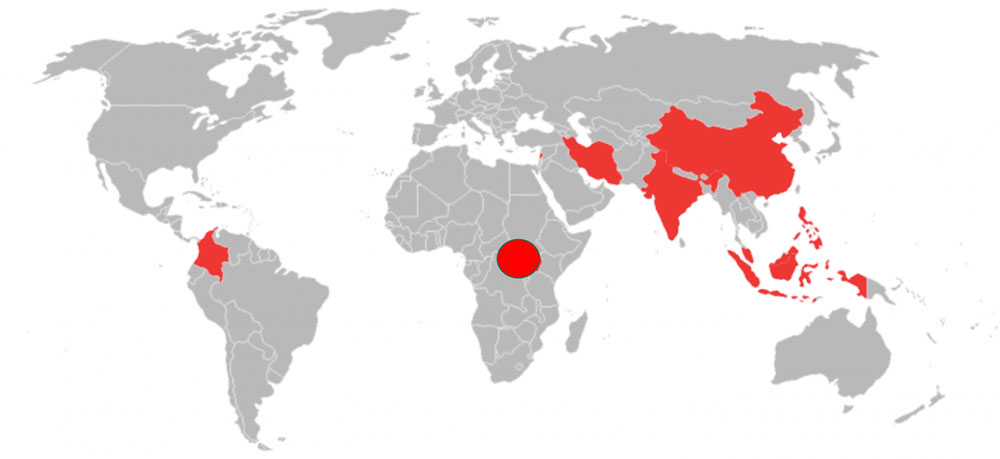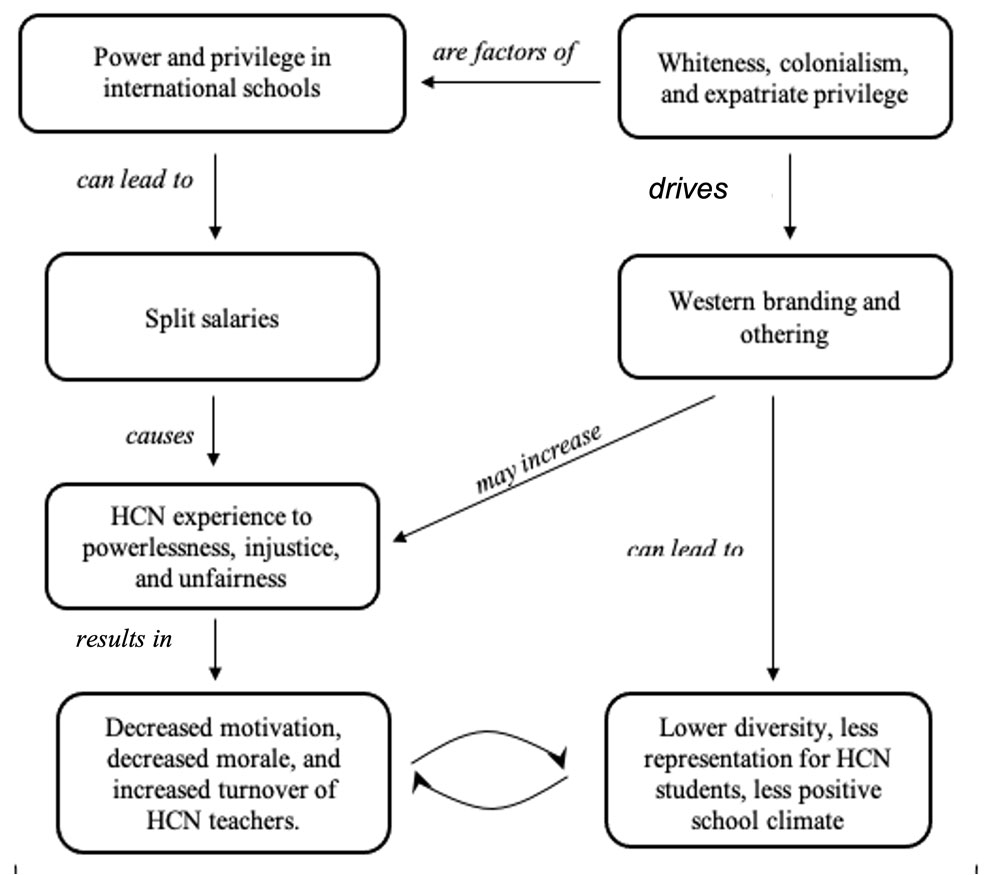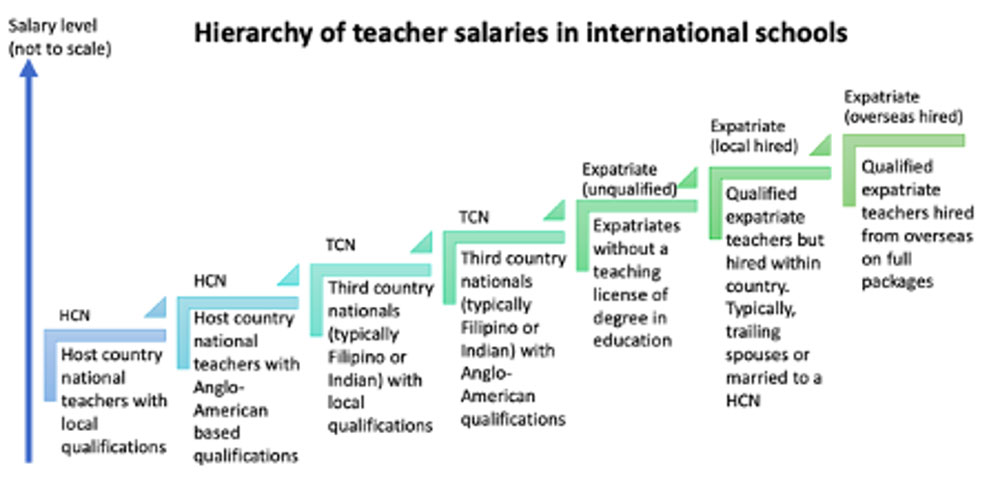
Figure 1: Internal research from the Academy of International School Heads (AISH)
---------------------------------------------------------------------------------
Since the term expatriate has different meanings and connotations around the world, for purposes of this article and research, the definitions intended are as follows: Expatriate: Employees who have transferred or self-initiated a move from one country to another for a specific period (Chen et al., 2002) and Expatriate teacher: Teachers who work in a country other than their own (Aydin et al., 2019) – which does not differentiate between Anglo-American countries and the Global South, though my study was really only looking at the expatriate compensation difference in international schools in the Global South.
“‘If we know better, we do better’ [Maya Angelou]. The question is, do schools want to do better and change this business model?” -Raya, Study Participant 2021
When I first moved overseas twenty-five years ago, I was vaguely aware that expatriates were paid more than their local host country national (HCN) colleagues. For a long time, I quietly accepted this inequity as normal, as legitimate and as justified, which was how Bunnell and Atkinson (2020) described this phenomenon. For instance, expatriate teachers have to pay for their student loans, mortgages back home, and the foreign exchanges on savings! But it did not sit right with me, and my disquiet grew. Once I moved into leadership of international schools, I became much more aware of just how significant this difference is.
The past two decades have seen an explosion in the growth of international schools, and schools calling themselves international. As the global international school industry grows, more HCN teachers are being employed alongside expatriate teachers in international schools. Internal research from the Academy of International School Heads (AISH) as seen in figure 1 indicates that in up to 32% of international schools surveyed, expatriate teachers are paid more than the local teaching staff for the same work (Parr, 2021). This is known as a split salary. Despite this prevalence, very little research on split salaries in international schools from the perspective of the HCN teachers has been conducted. My dissertation titled “Exploring the Ethnic Gap in Teacher Salaries in International Schools” set out to fill this research gap using Rawls’ (1991) theory of justice as fairness as a theoretical lens in which to examine this topic.
Method
I interviewed 10 HCN participants from different schools around the world using a semi-structured interview style. The participants represented Colombia, China, India, Indonesia, Iran, Malaysia, Lebanon, a central African country, and the Philippines. They had a variety of educational experiences and qualifications. Nine of the 10 participants held a Bachelor of Education, a Master of Teaching, a teaching license, or equivalent. Six held a Master’s degree. Nine of the 10 participants had travelled to and resided in countries outside of their country of origin, and eight had attended higher education institutions in Australia, the UK, or the USA. Two of the participants could be described as third culture kids (TCK) having attended international schools in Austria and Switzerland during their youth. Figure 2 shows a map of their countries of origin.

Figure 2: Countries represented in Hammers 2021 study
Findings
“This idea that we've kind of all internalized that everything Western is better and more valuable” and “the marketing [of international schools pushes this narrative], because how do we sell ourselves as an international school if we don't?” -Soha, Study Participant 2021
Data collected from the interviews were transcribed by software and then analyzed by hand for standard codes and themes as they emerged from the data, and the themes and subthemes were generated inductively. I had anticipated that I would find that the phenomenon was not fair. What I had not realized was that the key themes that emerged were much deeper and included: 1. Power - which tends to belong to the Anglo-Western teachers, school administrators and school boards; 2. Othering – which is what these schools do in order to brand themselves and justify the differences in salaries between different teacher nationalities; and 3. the Cost of Compromise - as the HCN teachers internally battle with reconciling themselves working in an environment that implicitly says they will never be good enough. As Soha, one of my study participants told me, “I left the country [Lebanon] because I knew there was no future for me.” Figure 3 indicates the factors of the inequities in international schools.

Figure 3: Systematic inequality factors in International Schools
Reflection on the study
“…basically offered it to a new teacher, he was English and got it. He had no experience at all, but he was, he had the right passport.” -Carmen, Study Participant, 2021
In the process of this study, I was contacted by several expatriate teachers who did not want me to publish a study like this, perhaps because they saw it as a threat to their salaries and benefits. One expatriate teacher wrote to me that my research would be “biased and not support reality” another two both complained that I was neglecting the injustice of locally hired expatriate teachers not receiving the same benefits as overseas hired expatriates. Figure 4 shows the different levels or hierarchy of teacher salaries that can exist in some international schools. I was also contacted by an owner of a school who claimed to have information showing why he had to employ split salaries to keep his school profitable. As these people did not fit into my eligibility criteria for the study, I politely declined their assistance. But I found this pushback disturbing.

Figure 4: Hierarchy of teacher salaries
Conclusion
“…and I remember walking into the room, you know, showing me around and I walked into the staff room and everybody like just stopped and looked at me, and everybody was white in the room, and I remember feeling, “Oh, interesting, where are all the other people?” -Raya, Study Participant, 2021
Using a purely competitive business approach to staffing does not align with international school missions. If international schools want to adhere to their missions and be truly diverse, equitable, inclusive, and just, they must examine the current economic models that justify split salaries and find alternatives or mitigations. This research can inform administrators and school owners that international schools should no longer be bastions of privilege.
References
Bunnell, T. & Atkinson C. (2020). Exploring enduring employment discrimination in favour of British and American teachers in ‘traditional international schools.’ Journal of Research in International Education 2020, Vol. 19(3) 251–267
Hammer, L. L. (2021). Exploring the Ethnic Gap in Teacher Salaries in International Schools (Doctoral dissertation, Wilkes University).
Parr, M. (2021) Academy International School Heads Survey: Overseas and Local Hire (Unpublished). Retrieved from https://www.academyish.org/.
Liam is Campus Principal at Tenby Schools Johor (Setia Eco Gardens) in Malaysia.
Twitter @Pak_Liam
LinkedIn: Liam Hammer